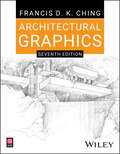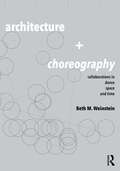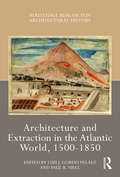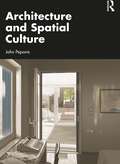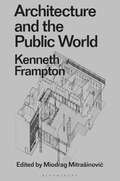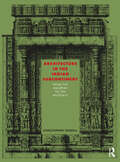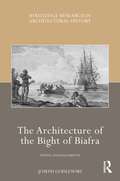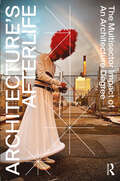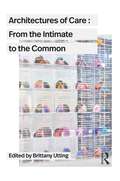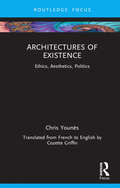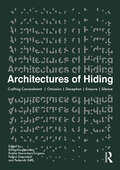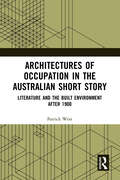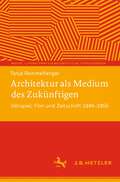- Table View
- List View
Architectural Graphics
by Francis D. ChingARCHITECTURAL GRAPHICS Architectural Graphics is the classic bestselling reference by one of the leading global authorities on architectural design drawing, Francis D. K. Ching. This seventh edition offers a comprehensive introduction to graphic tools and drafting conventions to translate architectural ideas into effective visual presentations, using hundreds of the author’s distinctive drawings to illustrate each topic. Updated throughout, this revised edition presents new beginner-friendly guidance for perspectives and sketching, updates on hand rendering and visual communication, and additional material on transitioning from analog to digital with CAD and digital drawing tools. Architectural graphics are key tools for conveying design through representation on paper or on screen. This book is the ultimate guide to mastering the skill and applying your talent to create more effective design communication, teaching how to: Understand multiview, paraline, and perspective drawing Master interior sections using a variety of techniques Render tonal value, enhance depth, and convey illumination Develop professional-quality layouts for presentations Architectural graphics both inform the design process and serve as the means by which a design is interpreted and built. Complete mastery of the tools and conventions is essential to the successful outcome of any project, and mistakes can cause confusion, time delays, increased costs, and possible catastrophe. Architectural Graphics is the comprehensive guide to professional architectural drawing, with insight from a leading authority.
Architectural Graphics
by Francis D. ChingARCHITECTURAL GRAPHICS Architectural Graphics is the classic bestselling reference by one of the leading global authorities on architectural design drawing, Francis D. K. Ching. This seventh edition offers a comprehensive introduction to graphic tools and drafting conventions to translate architectural ideas into effective visual presentations, using hundreds of the author’s distinctive drawings to illustrate each topic. Updated throughout, this revised edition presents new beginner-friendly guidance for perspectives and sketching, updates on hand rendering and visual communication, and additional material on transitioning from analog to digital with CAD and digital drawing tools. Architectural graphics are key tools for conveying design through representation on paper or on screen. This book is the ultimate guide to mastering the skill and applying your talent to create more effective design communication, teaching how to: Understand multiview, paraline, and perspective drawing Master interior sections using a variety of techniques Render tonal value, enhance depth, and convey illumination Develop professional-quality layouts for presentations Architectural graphics both inform the design process and serve as the means by which a design is interpreted and built. Complete mastery of the tools and conventions is essential to the successful outcome of any project, and mistakes can cause confusion, time delays, increased costs, and possible catastrophe. Architectural Graphics is the comprehensive guide to professional architectural drawing, with insight from a leading authority.
Architecture and Choreography: Collaborations in Dance, Space and Time
by Beth WeinsteinArchitecture and Choreography: Collaborations in Dance, Space and Time examines the field of archi-choreographic experiments—unique interdisciplinary encounters and performed events generated through collaborations between architects and choreographers.Forty case studies spanning four decades give evidence of the range of motivations for embarking on these creative endeavors and diverse conceptual underpinnings, generative methods, objects of inquiry, and outcomes. Architecture and Choreography builds histories and theories through which to examine these works, the contexts within, and processes through which the works emerged, and the critical questions they raise about ways to work together, sites and citations, ethics and equity, control and agency. Three themes frame pairs of chapters. The first addresses disciplinarity through works that critically reflect upon their discipline’s tools, techniques, and conventions juxtaposed against projects that cite or use other art forms and cultural phenomena as source material. The second interrogates space and the role of spatial dispositifs, institutions, and sites, and their hidden and not-so-hidden conditions, as conceptual drivers and structures to subvert, trouble, unsettle, remember. The third asks who and what dances, finding a spectrum from mobilized architectural bodies to more-than-human cybarcorps. Modes of collaboration and the temporalities and life cycles of projects inform bookending chapters.Architecture and Choreography offers vital lessons not only for architects and choreographers but also for students and practitioners across design and performance fields.
Architecture and Choreography: Collaborations in Dance, Space and Time
by Beth WeinsteinArchitecture and Choreography: Collaborations in Dance, Space and Time examines the field of archi-choreographic experiments—unique interdisciplinary encounters and performed events generated through collaborations between architects and choreographers.Forty case studies spanning four decades give evidence of the range of motivations for embarking on these creative endeavors and diverse conceptual underpinnings, generative methods, objects of inquiry, and outcomes. Architecture and Choreography builds histories and theories through which to examine these works, the contexts within, and processes through which the works emerged, and the critical questions they raise about ways to work together, sites and citations, ethics and equity, control and agency. Three themes frame pairs of chapters. The first addresses disciplinarity through works that critically reflect upon their discipline’s tools, techniques, and conventions juxtaposed against projects that cite or use other art forms and cultural phenomena as source material. The second interrogates space and the role of spatial dispositifs, institutions, and sites, and their hidden and not-so-hidden conditions, as conceptual drivers and structures to subvert, trouble, unsettle, remember. The third asks who and what dances, finding a spectrum from mobilized architectural bodies to more-than-human cybarcorps. Modes of collaboration and the temporalities and life cycles of projects inform bookending chapters.Architecture and Choreography offers vital lessons not only for architects and choreographers but also for students and practitioners across design and performance fields.
Architecture and Extraction in the Atlantic World, 1500-1850 (Routledge Research in Architectural History)
by Luis Gordo Peláez Paul NiellThis edited collection examines the development of Atlantic World architecture after 1492. In particular, the chapters explore the landscapes of extraction as material networks that brought people, space, and labor together in harvesting raw materials, cultivating agriculture for export-level profits, and circulating raw materials and commodities in Europe, Africa, and the Americas from 1500 to 1850. This book argues that histories of extraction remain incomplete without careful attention to the social, physical, and mental nexus that is architecture, just as architecture’s development in the last 500 years cannot be adequately comprehended without attention to empire, extraction, colonialism, and the rise of what Immanuel Wallerstein has called the world system. This world system was possible because of built environments that enabled resource extraction, transport of raw materials, circulation of commodities, and enactment of power relations in the struggle between capital and labor. Separated into three sections: Harvesting the Environment, Cultivating Profit, and Circulating Commodities: Networks and Infrastructures, this volume covers a wide range of geographies, from England to South America, from Africa to South Carolina. The book aims to decenter Eurocentric approaches to architectural history to expose the global circulation of ideas, things, commodities, and people that constituted the architecture of extraction in the Atlantic World. In focusing on extraction, we aim to recover histories of labor exploitation and racialized oppression of interest to the global community. The book will be of interest to researchers and students of architectural history, geography, urban and labor history, literary studies, historic preservation, and colonial studies.
Architecture and Extraction in the Atlantic World, 1500-1850 (Routledge Research in Architectural History)
This edited collection examines the development of Atlantic World architecture after 1492. In particular, the chapters explore the landscapes of extraction as material networks that brought people, space, and labor together in harvesting raw materials, cultivating agriculture for export-level profits, and circulating raw materials and commodities in Europe, Africa, and the Americas from 1500 to 1850. This book argues that histories of extraction remain incomplete without careful attention to the social, physical, and mental nexus that is architecture, just as architecture’s development in the last 500 years cannot be adequately comprehended without attention to empire, extraction, colonialism, and the rise of what Immanuel Wallerstein has called the world system. This world system was possible because of built environments that enabled resource extraction, transport of raw materials, circulation of commodities, and enactment of power relations in the struggle between capital and labor. Separated into three sections: Harvesting the Environment, Cultivating Profit, and Circulating Commodities: Networks and Infrastructures, this volume covers a wide range of geographies, from England to South America, from Africa to South Carolina. The book aims to decenter Eurocentric approaches to architectural history to expose the global circulation of ideas, things, commodities, and people that constituted the architecture of extraction in the Atlantic World. In focusing on extraction, we aim to recover histories of labor exploitation and racialized oppression of interest to the global community. The book will be of interest to researchers and students of architectural history, geography, urban and labor history, literary studies, historic preservation, and colonial studies.
Architecture and Spatial Culture
by John PeponisBuilt space supports our daily habits and our membership of communities, organizations, institutions, or social formations. Architecture and Spatial Culture argues that architecture matters because it makes the settings of our life intelligible, so that we can sustain or creatively transform them.As technological and social innovations allow us to overcome spatial constraints to communication, cooperation, and exchange, so the architecture of embodied experience reflects independent cultural choices and human values. The analysis of a wealth of examples, from urban environments to workplaces and museums, shows that built space functions pedagogically, inducing us to specific ways of seeing, understanding, and feeling, and supporting distinct patterns of cooperation and life in common.Architecture and Spatial Culture is about the principles that underpin the design and inhabitation of space. It also serves as an introduction to Space Syntax, a descriptive theory used to model the human functions of layouts. Thus, it addresses architects, students of architecture and all those working in disciplines that engage the design of the built environment and its social effects.
Architecture and Spatial Culture
by John PeponisBuilt space supports our daily habits and our membership of communities, organizations, institutions, or social formations. Architecture and Spatial Culture argues that architecture matters because it makes the settings of our life intelligible, so that we can sustain or creatively transform them.As technological and social innovations allow us to overcome spatial constraints to communication, cooperation, and exchange, so the architecture of embodied experience reflects independent cultural choices and human values. The analysis of a wealth of examples, from urban environments to workplaces and museums, shows that built space functions pedagogically, inducing us to specific ways of seeing, understanding, and feeling, and supporting distinct patterns of cooperation and life in common.Architecture and Spatial Culture is about the principles that underpin the design and inhabitation of space. It also serves as an introduction to Space Syntax, a descriptive theory used to model the human functions of layouts. Thus, it addresses architects, students of architecture and all those working in disciplines that engage the design of the built environment and its social effects.
Architecture and the Public World: Kenneth Frampton (Radical Thinkers in Design)
by Kenneth FramptonArchitecture and the Public World brings together key writings by Kenneth Frampton, the eminent architectural historian and critic, from the 1980s to the present. Articles are grouped into thematic sections representing abiding concerns of Frampton's criticism: history and critical theory; modes of criticism; the vicissitudes of urban form, and tactility, tectonics, and resistance. The volume also includes a new interview with Frampton and an essay by Clive Dilnot exploring the relevance of Frampton's thought for design history and criticism.The anthology represents Frampton's abiding concern for labor and the political dimensions of architecture, including his development of the concept of 'critical regionalism', but, in featuring writings from across the range and breadth of Frampton's career, enables a broader understanding of his work, demonstrating the potential for architectural interpretation and analysis to function as a mode of cultural criticism.
Architecture in the Indian Subcontinent: From the Mauryas to the Mughals
by Christopher TadgellDedicated to the tracing of continuity across sectarian divides, Christopher Tadgell’s History of Architecture in India (1989) was the first modern monograph to draw together in one volume all the strands of India’s pre-colonial architectural history – from the Vedic and Native traditions of early India, through Hindu, Buddhist, Islamic and secular architecture. This comprehensive revision, Architecture in the Indian Subcontinent: From the Mauryas to the Mughals, expands the structure to acknowledge the great advance in scholarship across this extremely complex subject over the last three decades. An understanding of Indian history and religion is the basis for understanding the complex pattern of relationships in the evolution of architecture in the subcontinent. Therefore, background material covers major invasions, migrations, dynastic conflicts and cultural and commercial connections, the main religious developments and their significance and repercussions, and external architectural precedents. While avoiding the usual division of the subject into ‘Buddhist and Hindu’ and ‘Islamic’ parts in order to trace continuity, the importance of religion, symbolism and myth to the development of characteristic Indian architectural forms in all their richness and complexity is fully explained in this fully illustrated account of the subcontinent’s architecture.
Architecture in the Indian Subcontinent: From the Mauryas to the Mughals
by Christopher TadgellDedicated to the tracing of continuity across sectarian divides, Christopher Tadgell’s History of Architecture in India (1989) was the first modern monograph to draw together in one volume all the strands of India’s pre-colonial architectural history – from the Vedic and Native traditions of early India, through Hindu, Buddhist, Islamic and secular architecture. This comprehensive revision, Architecture in the Indian Subcontinent: From the Mauryas to the Mughals, expands the structure to acknowledge the great advance in scholarship across this extremely complex subject over the last three decades. An understanding of Indian history and religion is the basis for understanding the complex pattern of relationships in the evolution of architecture in the subcontinent. Therefore, background material covers major invasions, migrations, dynastic conflicts and cultural and commercial connections, the main religious developments and their significance and repercussions, and external architectural precedents. While avoiding the usual division of the subject into ‘Buddhist and Hindu’ and ‘Islamic’ parts in order to trace continuity, the importance of religion, symbolism and myth to the development of characteristic Indian architectural forms in all their richness and complexity is fully explained in this fully illustrated account of the subcontinent’s architecture.
The Architecture of the Bight of Biafra: Spatial Entanglements (Routledge Research in Architectural History)
by Joseph GodlewskiThe Architecture of the Bight of Biafra challenges linear assumptions about agency, progress, and domination in colonial and postcolonial cities, adding an important sub‑Saharan case study to existing scholarship on globalization and modernity.Intersected by small creeks, rivulets, and dotted with mangrove swamps, the Bight of Biafra has a long history of decentralized political arrangements and intricate trading networks predating the emergence of the Atlantic world. While indigenous merchants in the region were active participants in the transatlantic slave trading system, they creatively resisted European settlement and maintained indigenous sovereignty until the middle of the nineteenth century. Since few built artifacts still exist, this study draws from a close reading of written sources—travelers’ accounts, slave traders’ diaries, missionary memoirs, colonial records, and oral histories—as well as contemporary fieldwork to trace transformations in the region’s built environment from the sixteenth century to today. With each chapter focusing on a particular spatial paradigm in this dynamic process, this book uncovers the manifold and inventive ways in which actors strategically adapted the built environment to adjust to changing cultural and economic circumstances. In parallel, it highlights the ways that these spaces were rhetorically constructed and exploited by foreign observers and local agents. Enmeshed in the history of slavery, colonialism, and the modern construction of race, the spatial dynamics of the Biafran region have not been geographically delimited. The central thesis of this volume is that these spaces of entanglement have been productive sites of Black identity formation involving competing and overlapping interests, occupying multiple positions and temporalities, and ensnaring real, imagined, and sometimes contradictory aims.This book will be of interest to researchers and students of architecture, architectural history, urban geography, African studies, and Atlantic studies.
The Architecture of the Bight of Biafra: Spatial Entanglements (Routledge Research in Architectural History)
by Joseph GodlewskiThe Architecture of the Bight of Biafra challenges linear assumptions about agency, progress, and domination in colonial and postcolonial cities, adding an important sub‑Saharan case study to existing scholarship on globalization and modernity.Intersected by small creeks, rivulets, and dotted with mangrove swamps, the Bight of Biafra has a long history of decentralized political arrangements and intricate trading networks predating the emergence of the Atlantic world. While indigenous merchants in the region were active participants in the transatlantic slave trading system, they creatively resisted European settlement and maintained indigenous sovereignty until the middle of the nineteenth century. Since few built artifacts still exist, this study draws from a close reading of written sources—travelers’ accounts, slave traders’ diaries, missionary memoirs, colonial records, and oral histories—as well as contemporary fieldwork to trace transformations in the region’s built environment from the sixteenth century to today. With each chapter focusing on a particular spatial paradigm in this dynamic process, this book uncovers the manifold and inventive ways in which actors strategically adapted the built environment to adjust to changing cultural and economic circumstances. In parallel, it highlights the ways that these spaces were rhetorically constructed and exploited by foreign observers and local agents. Enmeshed in the history of slavery, colonialism, and the modern construction of race, the spatial dynamics of the Biafran region have not been geographically delimited. The central thesis of this volume is that these spaces of entanglement have been productive sites of Black identity formation involving competing and overlapping interests, occupying multiple positions and temporalities, and ensnaring real, imagined, and sometimes contradictory aims.This book will be of interest to researchers and students of architecture, architectural history, urban geography, African studies, and Atlantic studies.
Architecture's Afterlife: The Multisector Impact of an Architecture Degree
by Michela Barosio Dag Boutsen Andrea Čeko Haydée De Loof Johan De Walsche Santiago Gomes Harriet Harriss Roberta Marcaccio Mia Roth-Čerina Carla Sentieri Neal Sashore Federica Vannucchi Hanne Van ReuselAlmost 40% of architecture graduates choose not to practise as architects. Instead, by ‘leaving’ their chosen profession, this surprisingly large but vastly overlooked cohort are making significant contributions to a wide range of other sectors, from politics to videogame design, demonstrating that architectural training can be a pathway to roles, and even leadership opportunities, across a variety of other professions.Architecture’s Afterlife is the first book to examine the sectors into which these graduates migrate, and to identify the transferable skills that are learned, but not always taught, in their degree programmes, and that prove most useful in their new careers.The book – a result of a three-year pan-European study funded by Erasmus+ – provides a roadmap for increasing graduate employment, addressing skills shortages across all sectors and adapting curricula to changing professional landscapes. It is therefore essential reading for all those responsible for curriculum design and delivery in architecture and other disciplines, including deans, professors, postgraduate researchers and policy makers, as well as students and professionals seeking to expand their career prospects.
Architecture's Afterlife: The Multisector Impact of an Architecture Degree
by Michela Barosio Dag Boutsen Andrea Čeko Haydée De Loof Johan De Walsche Santiago Gomes Harriet Harriss Roberta Marcaccio Mia Roth-Čerina Carla Sentieri Neal Sashore Federica Vannucchi Hanne Van ReuselAlmost 40% of architecture graduates choose not to practise as architects. Instead, by ‘leaving’ their chosen profession, this surprisingly large but vastly overlooked cohort are making significant contributions to a wide range of other sectors, from politics to videogame design, demonstrating that architectural training can be a pathway to roles, and even leadership opportunities, across a variety of other professions.Architecture’s Afterlife is the first book to examine the sectors into which these graduates migrate, and to identify the transferable skills that are learned, but not always taught, in their degree programmes, and that prove most useful in their new careers.The book – a result of a three-year pan-European study funded by Erasmus+ – provides a roadmap for increasing graduate employment, addressing skills shortages across all sectors and adapting curricula to changing professional landscapes. It is therefore essential reading for all those responsible for curriculum design and delivery in architecture and other disciplines, including deans, professors, postgraduate researchers and policy makers, as well as students and professionals seeking to expand their career prospects.
Architectures of Care: From the Intimate to the Common
Drawing from a diverse range of interdisciplinary voices, this book explores how spaces of care shape our affective, material, and social forms, from the most intimate scale of the body to our planetary commons.Typical definitions of care center around the maintenance of a livable life, encompassing everything from shelter and welfare to health and safety. Architecture plays a fundamental role in these definitions, inscribed in institutional archetypes such as the home, the hospital, the school, and the nursery. However, these spaces often structure modes of care that prescribe gender roles, bodily norms, and labor practices. How can architecture instead engage with an expanded definition of care that questions such roles and norms, producing more hybrid entanglements between our bodies, our collective lives, and our environments? Chapters in this book explore issues ranging from disabled domesticities and nursing, unbuilding whiteness in the built environment, practices and pedagogies of environmental care, and the solidarity networks within ‘The Cloud’. Case studies include Floating University Berlin, commoning initiatives by the Black Panther party, and hospitals for the United Mine Workers of America, among many other sites and scales of care.Exploring architecture through the lenses of gender studies, labor theory, environmental justice, and the medical humanities, this book will engage students and academics from a wide range of disciplines.
Architectures of Care: From the Intimate to the Common
by Brittany UttingDrawing from a diverse range of interdisciplinary voices, this book explores how spaces of care shape our affective, material, and social forms, from the most intimate scale of the body to our planetary commons.Typical definitions of care center around the maintenance of a livable life, encompassing everything from shelter and welfare to health and safety. Architecture plays a fundamental role in these definitions, inscribed in institutional archetypes such as the home, the hospital, the school, and the nursery. However, these spaces often structure modes of care that prescribe gender roles, bodily norms, and labor practices. How can architecture instead engage with an expanded definition of care that questions such roles and norms, producing more hybrid entanglements between our bodies, our collective lives, and our environments? Chapters in this book explore issues ranging from disabled domesticities and nursing, unbuilding whiteness in the built environment, practices and pedagogies of environmental care, and the solidarity networks within ‘The Cloud’. Case studies include Floating University Berlin, commoning initiatives by the Black Panther party, and hospitals for the United Mine Workers of America, among many other sites and scales of care.Exploring architecture through the lenses of gender studies, labor theory, environmental justice, and the medical humanities, this book will engage students and academics from a wide range of disciplines.
Architectures of Existence: Ethics, Aesthetics, Politics
by Chris YounèsArchitectures of Existence proposes that philosophical thinking (ecosophical thinking) can inform the way we engage with our world and its inhabitants, as architects, designers and planners, but also as individuals, as people, and as a society. In Art et existence, Maldiney states: "For us, to inhabit is to exist". This book aims to unfold, extend, articulate and thicken this postulate by interweaving architecture, city, landscape, literature and philosophy. It takes up the synergistic lines of long-term research carried out from an ecosophical perspective. Such an attitude explores an art of existing in multiplicity, singularity and openness, manifesting the critical dimension through a reinterpretation of the knotting of the trajectories of time, humanity and its becoming. Insisting on what is between things and beings as well as on what is happening, regenerating, recycling, reviving, saving, diversifying, sparing, recreating, meditating: and so caring. These are all eco-rhythms of a different type between human and non-human, to consider ourselves in the world. In an era of uncertainty and climate threats, this book develops the margins of possibility offered by the subject of architecture. This book will be of interest to researchers and students of architecture, urban planning and philosophy.
Architectures of Existence: Ethics, Aesthetics, Politics
by Chris YounèsArchitectures of Existence proposes that philosophical thinking (ecosophical thinking) can inform the way we engage with our world and its inhabitants, as architects, designers and planners, but also as individuals, as people, and as a society. In Art et existence, Maldiney states: "For us, to inhabit is to exist". This book aims to unfold, extend, articulate and thicken this postulate by interweaving architecture, city, landscape, literature and philosophy. It takes up the synergistic lines of long-term research carried out from an ecosophical perspective. Such an attitude explores an art of existing in multiplicity, singularity and openness, manifesting the critical dimension through a reinterpretation of the knotting of the trajectories of time, humanity and its becoming. Insisting on what is between things and beings as well as on what is happening, regenerating, recycling, reviving, saving, diversifying, sparing, recreating, meditating: and so caring. These are all eco-rhythms of a different type between human and non-human, to consider ourselves in the world. In an era of uncertainty and climate threats, this book develops the margins of possibility offered by the subject of architecture. This book will be of interest to researchers and students of architecture, urban planning and philosophy.
Architectures of Hiding: Crafting Concealment | Omission | Deception | Erasure | Silence
Architecture manifests as a space of concealment and unconcealment, lethe and alêtheia, enclosure and disclosure, where its making and agency are both hidden and revealed. With an urgency to amplify narratives that are overlooked, silenced and unacknowledged in and by architectural spaces, histories and theories, this book contends the need for a critical study of hiding in the context of architectural processes. It urges the understanding of inherent opportunities, power structures and covert strategies, whether socio-cultural, geo-political, environmental or economic, as they are related to their hidescapes – the constructed landscapes of our built environments participating in the architectures of hiding. Looking at and beyond the intentions and agency that architects possess, architectural spaces lend themselves as apparatuses for various forms of hiding and un(hiding). The examples explored in this book and the creative works presented in the interviews enclosed in the interludes of this publication cover a broad range of geographic and cultural contexts, discursively disclosing hidden aspects of architectural meaning. The book investigates the imaginative intrigue of concealing and revealing in design processes, along with moral responsibilities and ethical dilemmas inherent in crafting concealment through the making and reception of architecture.
Architectures of Hiding: Crafting Concealment | Omission | Deception | Erasure | Silence
by Rana Abughannam Émélie Desrochers-Turgeon Pallavi Swaranjali Federica GoffiArchitecture manifests as a space of concealment and unconcealment, lethe and alêtheia, enclosure and disclosure, where its making and agency are both hidden and revealed. With an urgency to amplify narratives that are overlooked, silenced and unacknowledged in and by architectural spaces, histories and theories, this book contends the need for a critical study of hiding in the context of architectural processes. It urges the understanding of inherent opportunities, power structures and covert strategies, whether socio-cultural, geo-political, environmental or economic, as they are related to their hidescapes – the constructed landscapes of our built environments participating in the architectures of hiding. Looking at and beyond the intentions and agency that architects possess, architectural spaces lend themselves as apparatuses for various forms of hiding and un(hiding). The examples explored in this book and the creative works presented in the interviews enclosed in the interludes of this publication cover a broad range of geographic and cultural contexts, discursively disclosing hidden aspects of architectural meaning. The book investigates the imaginative intrigue of concealing and revealing in design processes, along with moral responsibilities and ethical dilemmas inherent in crafting concealment through the making and reception of architecture.
Architectures of Occupation in the Australian Short Story: Literature and the Built Environment after 1900
by Patrick WestPatrick West’s Architectures of Occupation in the Australian Short Story cultivates the potential for literary representations of architectural space to contribute to the development of a contemporary politics of Australian post-colonialism.West argues that the predominance of tropes of place within cultural and critical expressions of Australian post-colonialism should be re-balanced through attention to spatial strategies of anti-colonial power. To elaborate the raw material of such strategies, West develops interdisciplinary close readings of keynote stories within three female-authored, pan-twentieth century, Australian short-story collections: Bush Studies by Barbara Baynton (1902); Kiss on the Lips and Other Stories by Katharine Susannah Prichard (1932); and White Turtle: A Collection of Short Stories by Merlinda Bobis (1999). The capacity of the short-story form to prompt creative and politically germinal engagements with species of space associated with architecture and buildings is underscored. Relatedly, West argues that the recent resurgence of binary thought—on local, national, and international scales—occasions an approach to the short-story collections shaped by binary relationships like a dichotomy of inside and outside. Concluding his argument, West connects the literary and architectural critiques of the story collections to the wicked problem, linked to ongoing colonial violences, of improving Australian Indigenous housing outcomes.Innovative and interdisciplinary, this book will be of interest to scholars and students of Literary, Architectural, and Postcolonial Studies. .
Architectures of Occupation in the Australian Short Story: Literature and the Built Environment after 1900
by Patrick WestPatrick West’s Architectures of Occupation in the Australian Short Story cultivates the potential for literary representations of architectural space to contribute to the development of a contemporary politics of Australian post-colonialism.West argues that the predominance of tropes of place within cultural and critical expressions of Australian post-colonialism should be re-balanced through attention to spatial strategies of anti-colonial power. To elaborate the raw material of such strategies, West develops interdisciplinary close readings of keynote stories within three female-authored, pan-twentieth century, Australian short-story collections: Bush Studies by Barbara Baynton (1902); Kiss on the Lips and Other Stories by Katharine Susannah Prichard (1932); and White Turtle: A Collection of Short Stories by Merlinda Bobis (1999). The capacity of the short-story form to prompt creative and politically germinal engagements with species of space associated with architecture and buildings is underscored. Relatedly, West argues that the recent resurgence of binary thought—on local, national, and international scales—occasions an approach to the short-story collections shaped by binary relationships like a dichotomy of inside and outside. Concluding his argument, West connects the literary and architectural critiques of the story collections to the wicked problem, linked to ongoing colonial violences, of improving Australian Indigenous housing outcomes.Innovative and interdisciplinary, this book will be of interest to scholars and students of Literary, Architectural, and Postcolonial Studies. .
Architektur als Medium des Zukünftigen: Hörspiel, Film und Zeitschrift 1945–1955 (Media. Literaturwissenschaftliche Forschungen)
by Tanja RommelfangerDas Buch beschäftigt sich mit der Architektur der unmittelbaren Nachkriegszeit als Gegenstand medialer Repräsentation. Dabei bewegt es sich im Spannungsfeld von Germanistik, Architekturgeschichte und Medienwissenschaft. Anhand von Radiohörspielen, Architekturzeitschriften und Filmen geht es der Frage nach, wie Architektur in Szene gesetzt wird. Dabei bezieht die Analyse mit ein, wie diese im Hinblick auf die Konstruktion und den Aufbau einer neuen Zukunft mit bestehenden Diskursen der Moderne in Verbindung gebracht wird und problematische Bezüge zur nationalsozialistischen Vergangenheit aufweist. In Werken von Günter Eich (Träume, 1951), Otto Renner (BAU. Zeitschrift für wohnen, arbeiten, sich erholen, 1947) und mit einem anonymen Städtefilm (Stein auf Stein. Ein Land baut auf, 1949) werden wenig bekannte Kurzformen aufgegriffen, um deren Verknüpfung mit neuen Medienverbunden und soziopolitischen Diskursen zu erforschen. Die detaillierten Analysen - von Eichs „Fünftem Traum“ als Mediengeflecht von Text, Musik und Geräusch, der heute wenig bekannten, aber zu ihrer Zeit renommierten Architekturzeitschrift BAU als Medienverbund aus zirkulierenden und wiederaufbereiteten Fotografien, Zeichnungen, Texten und Typografie und dem Kurzfilm Stein auf Stein mit seinen intermedialen Bezügen u.a. zur Fotografie - stellen Querverbindungen zu vielen Figuren und Werken dieser Zeit her, in der die Architektur eine Neubewertung als vermittelnde Instanz zwischen Individuum und Gesellschaft erfährt.Davon ausgehend schließt die Autorin auf größere Problematiken, die die Öffentlichkeit in den frühen Nachkriegsjahren beschäftigten. Dabei weist sie Momente des Exzesses und der Überschreitung in den Werken auf, die in einer Zeit der Ressourcenknappheit, Medienregulierung und konfliktreicher Lizensierungspolitik entstanden sind. Auch der Umbruch im Mediengefüge durch die Einführung von Fernsehen und die moralisch aufgeladene Debatte über eine entnazifizierte Öffentlichkeit werden reflektiert. Das Buch geht auch ausführlich auf die Besatzungspolitik im teilautonomen Saarland ein und führt die französische Kolonialpolitik in Algerien indirekt über die Rezeption Le Corbusiers in den deutschen Diskurs ein.Das Buch richtet sich an Studierende und Forschende der Fachgebiete Literatur-, Medien- und Kulturwissenschaft, Kunstgeschichte und Architektur.
Architekturleistungen des Späthistorismus: Nachblüte der Stilbaukunst um 1900 (Architekturen #77)
by Christian RablKaum ein Architekturphänomen ist dermaßen mit Diskredit behaftet wie der Späthistorismus, dessen künstlerische Gelingensbedingungen durch den Kulturumbruch des Fin de Siècle delegitimiert scheinen. Auch wenn die Stilbaukunst um und nach 1900 das bürgerlich-kapitalistische Zeitalter repräsentierte, so lassen sich darunter innovative Ansätze und eklektizistische Weiterschöpfungen ausmachen. Christian Rabl systematisiert diese stilarchitektonischen Fortschritte in ihren Einzelphänomenen - unter anderem an den späthistoristischen Stadtästhetiken von Madrid, Bukarest, Riga, Barcelona und Karlsbad.
